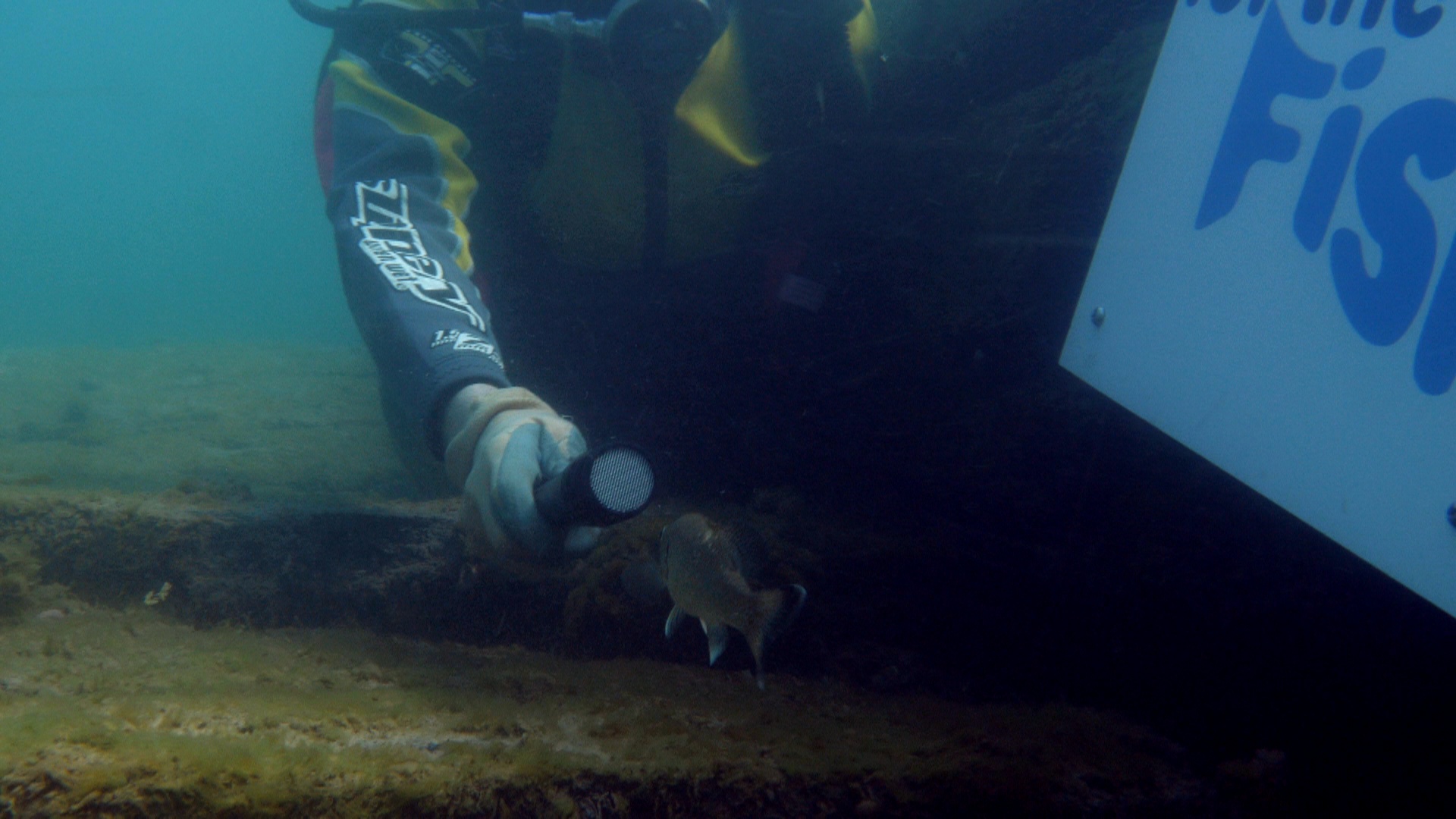
 I Speak for the Fish is a monthly column written by Great Lakes Now Contributor Kathy Johnson, coming out the third Monday of each month. Publishing the author’s views and assertions does not represent endorsement by Great Lakes Now or Detroit Public Television. Check out her previous columns.
I Speak for the Fish is a monthly column written by Great Lakes Now Contributor Kathy Johnson, coming out the third Monday of each month. Publishing the author’s views and assertions does not represent endorsement by Great Lakes Now or Detroit Public Television. Check out her previous columns.
In my first I Speak for the Fish column, published three years ago this month, I revealed my concern that the fixation with publishing stories about aquatic invasive species in the Great Lakes does the region no favors.
Bringing attention to issues is unquestionably an important part of the media’s role. But publishing story after story that simply reiterates the same negative content does not serve the greater good. Worse, it’s a disservice to the lakes.
My ongoing concern has been that the constant focus on invasive species would skew the public’s perception of the Great Lakes.
My fear likely seemed alarmist to some, but a recent travel update supports my concern.
Fodor’s is one of the most respected travel authorities in the world. Millions of people heed their recommendations. So, there was a collective Midwestern gasp when Fodor’s recently added Lake Superior to their “No List” for destinations to visit.
On the positive side, the list aims to draw attention to places where tourism is straining the ecosystem and encourage travelers to avoid those places to give the natural systems a break.
Reducing the impact of tourism is an endeavor I support.
However, in addition to issues like overrun campgrounds and polluted beaches in Michigan’s Upper Peninsula, Fodor’s specifically mentioned sea lamprey as one of the reasons travelers should avoid the area.
I honestly fail to see why the presence of sea lamprey in Lake Superior should deter a hiker from visiting Tahquamenon Falls. It is also seriously outdated information to suggest sea lampreys are a threat to the lake’s ecosystem.
The updated information is that 98% of all sea lampreys have been completely eliminated from the Great Lakes. The remaining 2% are well monitored and managed. Yet the stigma lives on.
Three years in, with some of my concerns recently realized, I’m more committed than ever for I Speak for the Fish to help shift the spotlight off invasives and onto native species.
Scoreboard
Last year, I ranked all the columns to date based on the number of page views, comments, likes, and shares each received on the Great Lakes Now website not including any social media platforms.

Kathy Johnson is covering the bottom of the Great Lakes for breaking fish news. (Photo Credit: Greg Lashbrook/PolkaDot Perch)
The results were so fascinating I decided to make it an annual thing and this past year did not disappoint!
I started writing this column before I had all the numbers because I felt confident the reigning champion would retain the title.
My first muskie column received over 20,000 views and has generated 23 comments and 10 likes on the Great Lakes Now website.
By comparison, the next closest generated about 10,000 views.

The muskellunge, otherwise affectionately known as the muskie (Photo Credit: Greg Lashbrook/PolkaDot Perch)
Muskies consistently outperform other species and not just in this column. In the past 18 months, the northern madtom segment in the November 2022 show has generated 1.6K views on YouTube while the muskie segment in this past February’s show has already gotten 103K views.
My confidence that no other fish species had a chance of unseating muskies as the reader’s favorite seemed like a safe bet. But I was wrong.
With 19,000 page views (and climbing) another species may soon dethrone the mighty muskie.
Of all the fish species covered so far, which do you think is challenging muskie for the top spot;
Or is the challenger one of the non-fish species including crayfish, mussels, cormorants, diving ducks, and jellyfish?
The Challenger
If you guessed smallmouth bass, well done!

Interviewing smallmouth bass for the I Speak for the Fish column. (Photo Credit: Greg Lashbrook/PolkaDot Perch)
Smallmouths are one of the few species that have as devoted and diehard a fan base as muskies. But smallmouths also have a national tournament that rolls into each town with all the pomp and fanfare of a NASCAR event.
Much like racecars, it’s hard to see a bass master’s boat beneath all the sponsorship insignia.
I get why anglers love smallmouth. I love smallmouth.
In my column, Never Underestimate a Smallmouth, I likened the way smallmouth bass guard their nests to German Shepherd attack dogs but I find the analogy runs deeper.
Like shepherds, adult smallmouths are one of the largest and most intelligent of their kind. Both learn very quickly. One to guide a blind person down a street the other to follow a diver around for an easy meal.

Smallmouth bass are looking to unseated muskies as the favorite I Speak for the Fish column. (Photo Credit: Greg Lashbrook/PolkaDot Perch)
Smallmouths are daring. They do not dart away in fear with each exhalation from my regulator. They move through the water with ease and confidence ready to meet head-on anything that comes their way.
Smallmouths were among the first native species to target the invasive round goby. The abundant food supply has led to increased size and numbers of smallmouth.
The bass targeting gobies has also taken pressure off some of the smallmouth’s other prey species like crayfish. At the same time, they are helping to reduce the overall number of gobies.
The smallmouth column has only been posted for a month and is already within striking distance of the muskie piece.
Will the smallmouth dethrone muskie as the most viewed I Speak for the Fish column? Readers will decide and I can’t wait to see who wins.
Honorable mention
Likes are appreciated as they are a tangible sign that readers enjoyed the piece. Each is valued.
Comments are also a great way for readers to actively participate in the column’s content. I do read the comments and appreciate readers taking the time to contribute.
While every single column has generated a few likes and the majority have garnered comments, shares are harder to come by.
If we included all the Great Lakes Now social media platforms then the number of shares goes up significantly. But direct shares from the website are more limited except for one piece.
My jellyfish column generated likes, comments, and more shares than any other column in the last year.

Jellyfish in the water. (Photo Credit: Greg Lashbrook/PolkaDot Perch)
I can understand why. Who knew there were freshwater jellyfish?
I can also understand why a piece about jellyfish in the Great Lakes would get widely shared. After all, the internet is fueled by strange, unusual, and check-this-out posts.
Three years and 22 species covered! I’m extremely thankful for every view, like, comment, and share.
Special thank you to all the people at Great Lakes Now who help make this column possible each month including copy editor Lisa John Rogers, video editor Jordan Wingrove, webmaster Mila Murray, and executive producer Rob Green.
Catch more news at Great Lakes Now:
I Speak for the Fish: Never underestimate a smallmouth
I Speak for the Fish: When a bass is not a bass
Featured image: Reporting the latest news from yellow perch in the Great Lakes. (Photo Credit: Greg Lashbrook/PolkaDot Perch)




